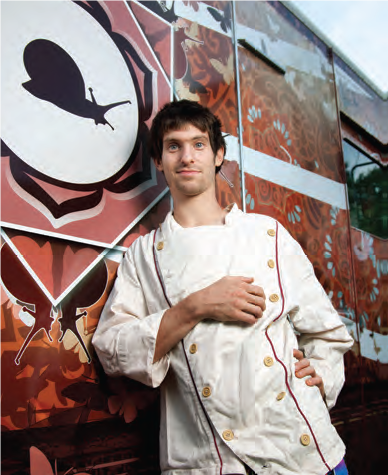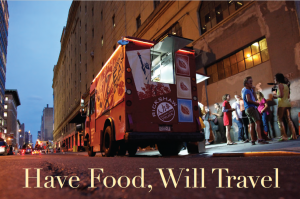Gourmet Food Trucks Go Full Throttle
Early morning. My friend, Pam, jumps off the ferry at Pier 17. As she scoots up Wall Street, she stops at a steaming cart to purchase the “best oatmeal in the world.” Next stop is a fresh fruit purveyor for just squeezed orange juice. Then on to another truck to buy “phenomenal” coffee. Breakfast in hand in only three minutes—a lot quicker than the corner diner—she heads up to catch the #6 subway. “I love buying food from these trucks,” she enthuses. Pam is an elegant woman in her 60s with high standards. She enjoys good food and dresses impeccably. So what is she doing ingesting food-on-the-fly (and from the street, no less)? My first reaction: Inoculate me…or at the very least pass the Tongue Purell! But since observing Pam grab food on the run that morning, I’ve noticed that food trucks have become ubiquitous, quite the thing and even chic on both sides of the Hudson. In the immortal words of Jimmy Durante, “Everybody’s getting in on the act.”
In his televised Bobby Flay’s Throwdown!, Iron Chef Bobby Flay has challenged to culinary cook-offs—and lost to—a number of food truck vendors. The New York Times food section regularly mentions these popular gourmet gypsies, and how and where to locate them. Zagats’ blog has launched a Food Truck Finder, providing parking location, reviews and even ratings of dozens of trucks—which is amazing since it didn’t include the popular Rickshaw Dumpling Truck, Kimchi Taco Truck, or King of Falafel. Even Food Network celebrity chef Tyler Florence has joined the movement, hosting The Great Food Truck Race, a culinary road show in which seven food trucks from California to Texas vie to be the most successful and win a $50,000 prize. Street food is older than a Babylonian bazaar. So what is creating this present-day proliferation of mobile food vending businesses? From Portland Oregon (600-plus trucks) to Austin, Texas, (more than 1,000), the mobile food business seems to be gaining momentum. It started on the West Coast (Los Angeles had food trucks as far back as the 1940s) and has headed East. Recently, Newsweek devoted an entire page to a wildly popular taco truck in L.A. Being in-the-know about a new restaurant, art installation or trend feeds the pop-up culture of the 3rd millennium, where businesses come and go in a matter of weeks. Often aided by social networks, a movable feast in a truck has become something for foodies to watch, follow, friend and tweet. Pam, my commuting friend, is no exception. She adores the thrill of discovery and being in on something new, delicious and personal.
KING OF QUEENS Krista, a chic young New Yorker, often grabs her dinner from King of Falafel in Astoria, Queens on the way home from her sales and marketing job. She says the very personal aspect of dining “a la cart” lends added appeal to the experience. “A huge part of what makes it so great are the people,” Krista explains. “There is always a long line of ‘Astorians’ of all ages and ethnicities waiting for the consistently delicious food. It’s fun to listen to the banter and the guys that work the cart are great. Oftentimes they give me some fresh falafel to munch on while I wait for my order of piles of marinated chicken and lots of tahini. And they tend to call me sweetie or sweetheart, which is actually kind of charming coming from them.” Not every food aficionado is on board with the truck trend. Once when the subject was raised, Mimi Sheraton, the former New York Times food critic, demanded to know “where the hell do you eat” the food? How about at the office, on a bench, or whatever conveyance takes you home? Since being inspired by Pam’s culinary trek up Wall Street, I have shared a Rickshaw Truck Hudson Valley Peking duck dumpling with my friend Sugie on the high seas (aka the Seastreak Ferry). I’ve even managed to carry a Dessert Truck sublime chocolate bread pudding all the way home before devouring it.
THE WHEEL DEAL Who are these enterprising mobile food vendors? Culinary school grads find the trucks a low-cost way to start a food following. Whereas opening a restaurant with rent and renovation might cost over $1 million, outfitting a gourmet food truck will cost between $75,000 for a used one and $200,000 for brand spanking new. New Jersey chef Adam Sobel purchased, outfitted and decorated his vegan food “Cinnamon Snail” truck for $26,000—acquiring the
used truck and supplies through Craigslist and paying his artistic and electronically savvy friends with free food. He has since upgraded the truck with $14,000 worth of improvements. Some restaurants wanting to deliver their food brand to other neighborhoods have started fleets of mobile food vendors. Rickshaw Dumpling, with a brick and mortar restaurant on West 23rd Street in New York, recently added another truck to service its curbside fans. On the other hand, some trucks—Dessert Truck and Cupcake Stop to name a couple—have actually engendered flagship restaurants. So you’re thinking of running a food truck? Thinking it might be fun, cheap and easy? Not so fast. In addition to the sometimes 90-hour-a-week time commitment, roadblocks and speed bumps include municipal bureaucracies with hard-to-obtain permits and licenses, monthly health inspections and police harassment. Also, strict and biased parking restrictions—such as parking too close to a crosswalk—can plague an enterprising food truck operator. As a result, the Street Vendor Project, an unofficial union of vendors, was formed as part of the Urban Justice Center in New York. To raise money to advocate for all street vendors, they initiated the Vendy awards, which Mario Batali calls “the Oscars for food for the real New York.”
JERSEY DRIVERS Gourmet trucks have started pulling into towns across New Jersey, too. However in many places restrictive ordinances can discourage the mobile food business. Sobel, a native of Red Bank, with a kitchen there, spent endless hours earlier this year trying to convince borough officials to carve out a spot where he (and others) could sell food near his home. During the warm-weather months, his Cinnamon Snail has a home every Sunday at the Red Bank Farmer’s Market. Jersey City and Hoboken are home to a number of trucks offering interesting fare. The aforementioned Cinnamon Snail, Two Pitas in a Pod, and the Taco Truck are among the more popular. In the highly competitive food business, one might surmise there is cutthroat competition or turf wars, but in fact there exists camaraderie and mutual respect among the mobile vendors. Indeed, they often swap meals for variety and friendship. Lev Ekster, the Cupcake Stop truck entrepreneur, opted out of law, hired some great bakers and started the first mobile cupcake shoppe. In less than two years, his cupcakes won the Food Network’s Food Feud for Best Cupcake. With a bakery in Montclair, a newly opened shop in Greenwich Village and a truck that ventures into Manhattan each day, Ekster seems to have all the bases covered. If you work in the city, you can even preorder cupcakes for the office and pick them up at his Twittered location. How tweet it is.







